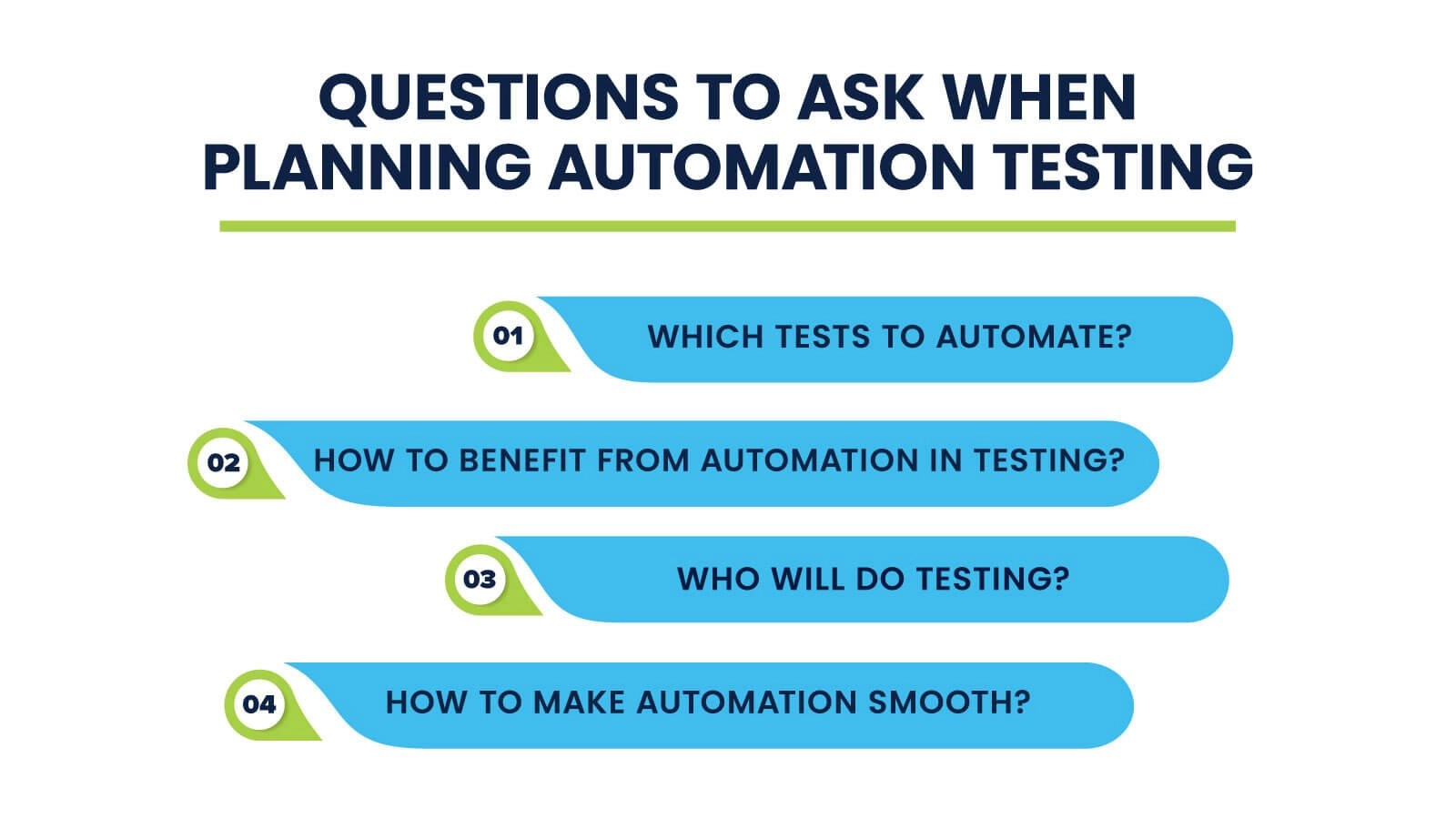We all imagine having the trip of a lifetime. Luxury hotels, exotic foods, beach huts, parties with friends, bonfires in the desert under the starry night sky. Oh, what a trip it would be. But to do all this, you need to plan. It starts with how to pull all that money together, which friends will accompany you, when and where to go, etc. There are so many things to think about to make it the trip of a lifetime! The success of your trip depends on how well you plan it. Just like this, implementing test automation also requires detailed planning in order to be successful. Without the right planning, your team will end up in a terrible mess. Here are a few questions to consider when planning for test automation.
You can only start doing a task when you have clarity on what to do. Like any other thing automation testing also starts with proper planning. The first step is to decide which steps to automate. Tests which are suitable for automation include repetitive tests, tests that check for different browser configurations and tests that check for components with the same workflow but in different environmental scenarios. If you are confused about whether to automate or not the following tests which make up half of the testing cycle, can easily be automated.
The tests above can easily be automated with the help of automation testing tools. They can also be integrated with a test management tool, such as Testworthy for good test case management.
Before buying stocks for investment, we look at which ones can give us a return. Similarly, you cannot just jump into automation without considering the returns and benefits. Test automation offers quite a few of these, it is effective, reliable, and a time saver. To truly take advantage of automation testing, consider the following points when deciding the tools and aids you will use to facilitate your tests.
To get solid outcomes from the automation of test cases consider your goals. Determining goals will also determine how feasible automating your testing processes is and which tools and software are most suitable to execute the automation.
You have given enough interviews to know that every position has different responsibilities and skills. Only the candidate that matches the required skill set and attitude, is offered the job. Remember this when assigning automation to someone on the team. Making the shift from manual to automated testing can be daunting, but having an expert on the team can make it less stressful. Find the people with the right technical and soft skills required for the job.
Primarily the following two can be considered:
Choosing the right person for testing boils down to the complexity of the software and the kind of expertise required for automation.
Things become smooth when you plan thoroughly and are ready for any problems. You have straightened out half the wrinkles when you have started to plan things. The remaining half will come out at the time of execution, which tells how well you planned things in the first place.
To execute automation testing, you need an automation tool. This tool will run the test scripts and provide you with insights and reports. Using the automation tool for the first time is a trial-and-error phase that will help you uncover what works for your application's testing and what doesn’t. It will also reveal how comfortable your testers were with the tool, the language, and the workflow. If one tool does not work out, you might need to consider another. So put in the time and effort to select the tool that works for you.
After figuring out the tools and the testers, there is no need to delay the execution phase any longer. It will only lead to late deployment of the software. Once you are confident in your planning, just get started!
Successful automation requires good planning. By considering a few essential questions, such as which tests to automate, who will be conducting automation, what are your specific goals and how to make automation a smooth process, you can ensure that your test automation is effective and achieves the desired results. Consider the questions above carefully so you can navigate through planning smoothly and achieve maximum benefit from automation.

Question 1: Which tests can I automate?
You can only start doing a task when you have clarity on what to do. Like any other thing automation testing also starts with proper planning. The first step is to decide which steps to automate. Tests which are suitable for automation include repetitive tests, tests that check for different browser configurations and tests that check for components with the same workflow but in different environmental scenarios. If you are confused about whether to automate or not the following tests which make up half of the testing cycle, can easily be automated.
- • Smoke tests check for the working of the entire system.
- • Integration tests evaluate the working of two components together in different environmental scenarios.
- • Unit tests check the working of a single unit.
- • Performance tests check the workload and stress the system can bear.
The tests above can easily be automated with the help of automation testing tools. They can also be integrated with a test management tool, such as Testworthy for good test case management.
Question 2: How can I benefit from automated testing?
Before buying stocks for investment, we look at which ones can give us a return. Similarly, you cannot just jump into automation without considering the returns and benefits. Test automation offers quite a few of these, it is effective, reliable, and a time saver. To truly take advantage of automation testing, consider the following points when deciding the tools and aids you will use to facilitate your tests.
- • Do I want to check for a specific bug with this automation? Then the tool should be able to check for that bug.
- • Do I need a tool that has scalability and self-healing? You need this if you have a complex application and limited resources.
- • What specific features do I want the testing report to show?
- • Will I also need a test management tool for test case management in automation?
- • Will using AI in automated testing be helpful to my resources?
To get solid outcomes from the automation of test cases consider your goals. Determining goals will also determine how feasible automating your testing processes is and which tools and software are most suitable to execute the automation.
Question 3: Which person on the team can take this job?
You have given enough interviews to know that every position has different responsibilities and skills. Only the candidate that matches the required skill set and attitude, is offered the job. Remember this when assigning automation to someone on the team. Making the shift from manual to automated testing can be daunting, but having an expert on the team can make it less stressful. Find the people with the right technical and soft skills required for the job.
Primarily the following two can be considered:
- •A team of software developers and QA testers together can conduct automation testing by creating and executing the relevant test cases. It saves time as the team spends more time writing test cases than running them, which increases the reliability of the application. This type of team is best suited to work on complex software with complicated back-end programming.
- • Business Tester: For less complex and non-technical applications business testers are suitable. These testers are aware of what the software aims to achieve and what features need to be there. They mostly engage in codeless testing, which is testing without code.
Choosing the right person for testing boils down to the complexity of the software and the kind of expertise required for automation.
Question 4: How to make automation testing a smooth process?
Things become smooth when you plan thoroughly and are ready for any problems. You have straightened out half the wrinkles when you have started to plan things. The remaining half will come out at the time of execution, which tells how well you planned things in the first place.
To execute automation testing, you need an automation tool. This tool will run the test scripts and provide you with insights and reports. Using the automation tool for the first time is a trial-and-error phase that will help you uncover what works for your application's testing and what doesn’t. It will also reveal how comfortable your testers were with the tool, the language, and the workflow. If one tool does not work out, you might need to consider another. So put in the time and effort to select the tool that works for you.
After figuring out the tools and the testers, there is no need to delay the execution phase any longer. It will only lead to late deployment of the software. Once you are confident in your planning, just get started!

Conclusion
Successful automation requires good planning. By considering a few essential questions, such as which tests to automate, who will be conducting automation, what are your specific goals and how to make automation a smooth process, you can ensure that your test automation is effective and achieves the desired results. Consider the questions above carefully so you can navigate through planning smoothly and achieve maximum benefit from automation.
FAQs
Test planning is a process in which testers create a plan to outline how the software will be tested, including what will be tested, when it will be tested, and how it will be tested. This process also involves the identification of different test strategies, test objectives, test resources, test schedules, and test environments to ensure that the software meets its quality standards. With Testworthy, you can create detailed, well-organized, and insights-driven test plans to make sure your QA efforts are always on the right path.
Here are some of the most important software testing tools offered by Testworthy:
- - Test management software: assists in the planning, organization, and tracking of testing progress
- - Test case management software: assists in the creation and management of test cases, scripts, and data.
- - Defect tracking software: assists in the tracking and management of identified defects and issues.
- - Test case execution software: assists in the automation and execution of test cases.
- - Requirements management software: assists in the management and tracking of requirements during the development process.
- - Project management software: assists in the management and tracking of the testing project's schedule, resources, and budget.
Here's how you can create an automated test plan using Testworthy:
- - Identify test objectives and requirements
- - Determine the scope and test strategy
- - Identify the test environment and resources needed
- - Design test cases and test scripts
- - Identify the test data needed
- - Implement automation testing
- - Schedule and execute the tests
- - Monitor and evaluate the results
- - Document and report the findings.